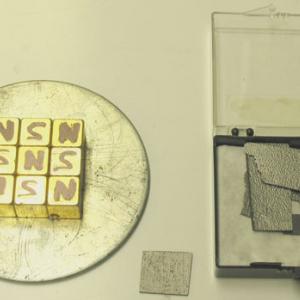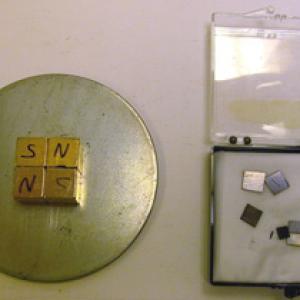College of Liberal Arts & Sciences
5G30.45 - Four and Nine Magnet Diamagnetic Levitator
Align the 9 magnets so that when they are facing up and alternating North/South with North poles on all corners of the square. Place the graphite above the center of the magnet square. It should float quite stably 1 or 2 mm above the magnets in a potential well that is produced by the quadrupole effect of the four South facing magnets.
A 4 magnet array ( 2 X 2 cube ) also works quite well for this demonstration.
- Ron Edge, "A Simple Diamagnetic Levitation Experiment", TPT, Vol. 41, # 2, p. 122, Feb 2003.
- Simon Quellen Fields, "Levitating Pyrolytic Graphite", Gonzo Gismos, p. 24 - 28.
- Theodore Gray, "Ignorance=Maglev=Bliss", Popular Science, Feb. 2004, p. 90.
Disclaimer: These demonstrations are provided only for illustrative use by persons affiliated with The University of Iowa and only under the direction of a trained instructor or physicist. The University of Iowa is not responsible for demonstrations performed by those using their own equipment or who choose to use this reference material for their own purpose. The demonstrations included here are within the public domain and can be found in materials contained in libraries, bookstores, and through electronic sources. Performing all or any portion of any of these demonstrations, with or without revisions not depicted here entails inherent risks. These risks include, without limitation, bodily injury (and possibly death), including risks to health that may be temporary or permanent and that may exacerbate a pre-existing medical condition; and property loss or damage. Anyone performing any part of these demonstrations, even with revisions, knowingly and voluntarily assumes all risks associated with them.



